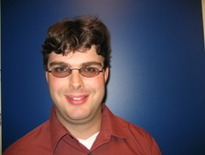Structural and electronic properties of Pt/Ge(001) and Au/Ge(001)
Promotion date: 5 June 2008
Thesis advisors: prof. dr. Harold J.W. Zandvliet, prof. dr. ir. Bene Poelsema
| Structural and electronic properties of the 1D structures, which are formed on a Ge(001) surface, after the deposition of Pt of Au, are studied with a Scanning Tunneling Microscope (STM). Also the dynamic behaviour of surface dimers is discussed using, among others, their flip-flopping properties. The properties of monoatomic Pt chains - one atom wide, up to a micron long - is described, and their exciting formation process is studied. Also electronic states between Pt chains are discussed. These states are exclusively present in the troughs. Furthermore, the metallicity of the chains at 4.7 K is reduced. This can be interpreted as a Peierls instability. |
It sounds like a pretty exciting promotion period you experienced
That it would be so much fun, I could never have thought of. Seeing individual atoms, see them organize line by line, that really is fascinating! Monatomic Pt chains only grow on specific Pt-modified terraces. The wires emerge from the surface, like a nanoscale zipper. In this way, I was able to tell the making story of the thinnest wires that exist in the world, one atom in diameter and thousands of atoms long.
Is it hard to make this kind of real important observations?
To reach this kind of results, on the one hand, your preparation for the emperiments must be the best you can. For example, preparing the needle of the Scanning Tunneling Microscope can take up to half a day, shaping the tip apex by applying an electric field. The sharpness of the needle needs to be atomic and also the shape is important. When you reach maximum resolution, that is a dream. I think I made a total of 10.000 observations in total.
On the other hand, never say to quickly to yourself an experiment has failed completely. Presents do exist. And meaning behind the data can be hidden, in a surprising kind of way. That is the way it goes when you are working on the brim of what is possible and what is not. It is like trying to look over a fence. Nine times out of ten, you don't succeed, one time you gain new information, in one way or the other.
You use the STM. Does it take long to learn to work with it?
STM is a very powerful tool in nanotechnology, that was already recognized by rewarding its inventors in their nobelprize, in 1985. The variety of measurements possible is endless, moving the tip, or not, varying the voltage difference, positive and negative, the way of approaching the surface under investigation. These are only a few rudimentary examples.
At low temperature observations, combining lock-in and scanning techniques, we saw electronic behaviour we could not explain at first. It took almost half a year, before discovering that electrons performed a one-dimensional pattern of moving. At last we reached a hundred procent solid proof, the electronic state was exclusively between the Pt wires under investigation. A very surprising and meaningful result.
By lots of experience, perseverence and curiosity, you learn to know the apparatus you are working with, and then these kind of results can occur. There also exists a theoretical component, in trying to explain the measurements. I gained a thorough knowledge, by study, of course, but also by discussions with team members and experts like Harold Zandvliet, always trying to convince eachother about the data, the meaning of them, and the theoretical consequences.
What about your future plans?
In the near future I will be working for FOM Plasmafysica in Rijnhuizen, near Nieuwegein. There I will be studying multilayered mirrors, in the Röntgen-area, usable in the next generation wafersteppers. The way substrates are created, and the atomic compositions, I am familiar with. But the scale is somewhat larger.
I look upon it as sniffing a bit towards more commercial kind of research. However, for the moment, an academic career is still an attractive idea. There you have more freedom of choice, and working with young enthousiastic people I find very attractive. You can learn a lot, from everybody. In this project I got into contact with a great variety of expertise. One student was very handy, using printerboard-like techniques, another could make very complex 3D representations, and a third student helped me a great deal analyzing data.
Do you have a final message for MESA+?
Well ... It is a great institute, of course ...
I think it is important to keep doing the good fundamental work. That is the basis where the specific knowledge is build up. The other way around, trying to build spin-off devices can help to trigger the fundamental research topics. I am confident they will do alright here at MESA+. And perhaps in the future I will have the chance to return. You never know ...

